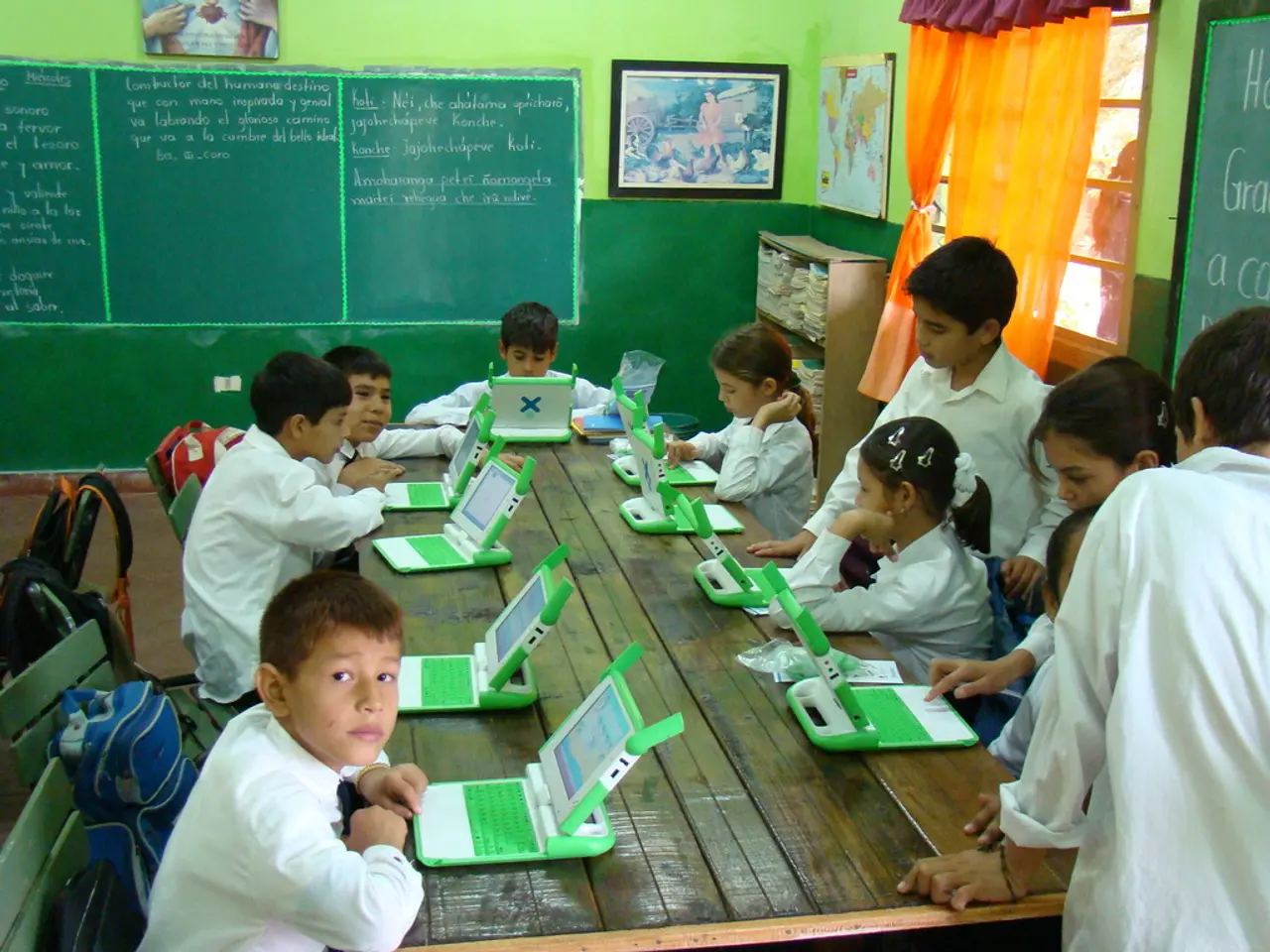Online Systems' Impact on Modernizing Traditional School Education Structures
Modernizing Education: The Digital Classroom Revolution
Education, as we know it, has undergone a remarkable metamorphosis with technology taking the driver's seat. In the current climate, parents are concerned about their child falling behind - a worry that's been amplified by the pandemic. To address this concern and prepare children for an increasingly digital future, schools are eagerly adopting innovative digital solutions.
Today's classrooms transcend traditional methods with digital tools reshaping both student interactions and teacher-student dynamics. Gone are the days of chalkboards and textbooks as tablets and online learning in schools become the new norm.
The Transformation of Classrooms through Digital Innovation
The leap from traditional teaching to tech-enhanced learning represents one of the most significant shifts in education. Digital tools are opening up a world of possibilities, transforming learning experiences for both teachers and students.
Nowadays, the classroom looks drastically different from the one we might remember. Interactive whiteboards have replaced chalkboards, and remote collaboration has made its way into classrooms through the use of digital platforms. This digital revolution isn't just about shiny new gadgets; it's about revolutionizing learning and skill development.
Schools face multifarious challenges, including limited resources, student disengagement, and the need to equip students for jobs that don't yet exist. Education technology steps in to solve these challenges by making quality resources accessible for all students, reinventing learning for the 21st century.
Digital tools don't just change what students learn; they alter the way they learn. They help students visualize complex concepts, work together remotely, and receive immediate feedback on their work. Teachers gain the ability to track student progress efficiently and provide targeted help sooner when students need it.
Virtual tutoring programs, for example, offer students academic assistance beyond classroom hours, bridging learning gaps, reinforcing key concepts, and ensuring that every student receives the support they need — no matter where they are or what their schedule looks like.
The Evolving Landscape of Education Technology
EdTech has come a long way from early school computer labs and educational software. Today's digital tools are more intelligent, accessible, and integrated into every aspect of learning.
Technology may not be new to the classroom, but earlier implementations were often separate from regular classroom activities, used only occasionally. The emergence of the internet brought about a turning point, enabling seamless online learning and collective platforms as learning management systems entered the picture. The introduction of tablets and affordable laptops further revolutionized the learning experience by giving students access to computing power right at their desks.
Integrating Tech into Every Aspect of Learning
Today, digital tools are no longer just supplemental classroom tools; they're key components of holistic learning ecosystems. Schools are implementing integrated platforms that connect all education aspects, from attendance and gradebooks to instruction and assessment.
The Core Advantages of Digital Learning Platforms in Modern Education
Modern online education platforms present multiple benefits that raise the bar for learning experiences across the board. These benefits address many of the challenges modern education faces.
Elevated Accessibility and Inclusion
One of the hallmarks of modernizing education is how technology democratizes learning opportunities. Digital platforms make high-quality education more accessible to a diverse group of learners.
Erasing Geographical Barriers
Top-tier instruction is available to students anywhere thanks to online platforms – eliminating the need for students to be physically present at prestigious institutions to access exceptional resources.
Catering to Different Learning Needs
Digital tools provide flexibility for students with unique learning styles and abilities. Features like text-to-speech, closed captioning, and adjustable reading levels cater to different learners, including those with disabilities.
Leveling the Playing Field
Education technology helps bridge learning gaps by offering resources to underserved communities. Students from all backgrounds can access advanced courses, specialized instruction, and enrichment activities that might otherwise be unavailable to them.
Personalized Learning Experiences
Imagine your learning experience being customized for your unique strengths, weaknesses, and learning style. With modern educational technology, that's a reality.
AI-Powered Adaptive Learning
Advanced algorithms monitor student performance and modify content difficulty, pace, and presentation dynamically – creating a learning experience tailored to each student.
Custom Learning Pathways
Digital platforms empower teachers to assign personalized learning sequences based on individual assessment data, ensuring that education remains student-focused and flexible.
Self-Paced Learning Opportunities
Students can progress at their preferred speed, spending more time on challenging concepts while moving swiftly through content they already understand. This reduces frustration for both struggling and gifted learners.
The personalization capabilities of modern educational platforms represent a paradigm shift from one-size-fits-all instruction to truly student-centered learning tailored to each learner's needs. These individualized approaches foster higher engagement through engaging, interactive experiences.
Embracing the Digital Future
Online education platforms in schools represent more than just the adoption of new technology – it's a reimagination of education. While challenges persist, such as ensuring equitable access and balancing screen time with other learning experiences, the impact of educational technology is undeniable. Schools that wisely integrate digital learning tools while prioritizing human connections and holistic student development will succeed in preparing young people for the opportunities ahead.
As we forge ahead into the future, one thing is clear: the smart blending of technology will continue shaping learning experiences that are more personalized, engaging, and effective than ever before.
Frequently Asked Questions About Education Technology
How does technology change teachers' roles in the classroom?
Technology won't replace teachers but will transform their roles from information providers to learning facilitators. As content is delivered by digital tools, teachers will spend more time mentoring students, leading discussions, and offering targeted support.
What are the most cost-effective ways to incorporate digital learning tools into schools with limited budgets?
Affordable solutions include capitalizing on open educational resources, implementing BYOD (Bring Your Own Device) policies, and using strategic implementation strategies that prioritize the most impactful tools first.
How can schools ensure equal access to technology for all students?
Providing equal access requires multiple strategies, such as implementing device-lending programs, establishing community partnerships for home internet access, extending school hours for technology use, and ensuring digital resources are compatible across various platforms and devices.
Sources:
[1] Chaman, N. (2021). The Role and Importance of Online Learning in Modern Times. Retrieved from https://onlinecourses.au.edu/online-learning/role-importance-online-learning-modern-times/
[2] Hodges, C. (2019). The three biggest benefits of online learning. Retrieved from https://www.forbes.com/sites/michaelmolio/2019/07/15/the-three-biggest-benefits-of-online-learning/?sh=441ac8427d24
[3] Salmon, G. (2021). Online Education vs Traditional Classroom Learning: The Pros and Cons. Retrieved from https://www.learninghouse.com/resources/insights/online-education-vs-traditional-classroom-learning-the-pros-and-cons
[4] Wellman, B. (2014). Social Media and Student Learning Engagement: Ambivalence and Struggle. Retrieved from https://journals.sagepub.com/doi/abs/10.1177/1521006X14566925
In the modern digital landscape of education, innovative online learning platforms are revolutionizing classroom dynamics, offering a personalized, accessible, and interactive educational experience tailored to each student's needs (learning, self-development). These tools are integral to the evolving landscape of education technology, a departure from traditional methods, transforming learning experiences and enabling real-time collaboration, adaptive learning, and targeted teacher support (education-and-self-development, innovation, online-education, learning). By democratizing access to quality education and catering to diverse learning styles, digital platforms level the playing field for all students, erasing geographical barriers and providing resources for underserved communities (accessibility and inclusion). The smart blending of technology in education will continue to reshape traditional teaching methods, enhancing the effectiveness and engagement of learning experiences for students and teachers alike (embracing the digital future).








